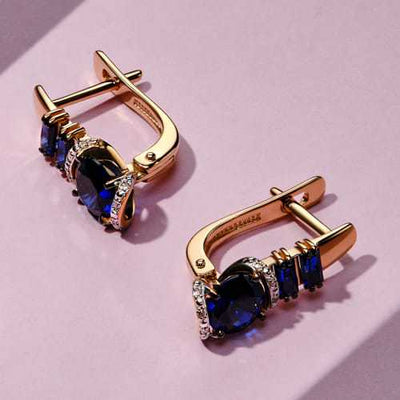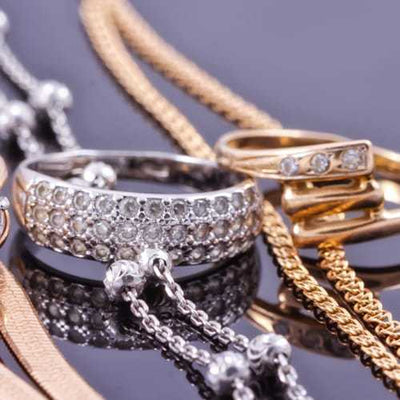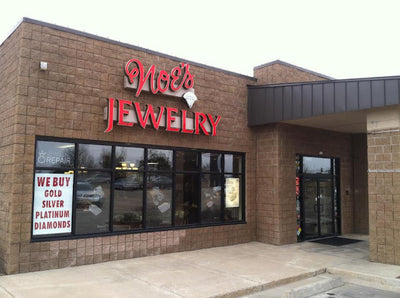What is an Opal?
Opals are gems made from hydrous silicon dioxide. To create an opal, water seeps through sandstone and picks up silica particles. Millions of years ago, the silica-filled water filled in the cracks and voids in sedimentary and volcanic areas in Australia and other parts of the world. It took another million or two years for the rock to solidify into opals.
Opals are considered amorphous, which means that they lack a crystalline structure. In addition, opals don’t have a well-defined chemical composition because they contain a variable amount of water. In fact, opals can contain anywhere from three to 20 percent of water within its silica structure. This means that opals are considered a mineraloid—not a mineral. Opals belong to the same family as agate and quartz; however, opals are different because they form as amorphous lumps of silica instead of naturally faceted crystals.
The word opal comes from the Greek word “opallios,” which means “to see a change in color.” The term is fitting since opals tend to look different depending on how light is diffracted in the stone. When writing about opals, Roman scholar Pliny used the word “opalus” to describe the kaleidoscopic effect that the stones have as they display a rainbow of colors.
The cause of this unique coloration is microscopic silica spheres in the opals that diffract light to display a variety of different colors. These colorful flashes of light are referred to as “play-of-color.”
Beautiful and unique, opals are one of two birthstones for the month of October, along with tourmaline, which also comes in a variety of colors.
Types of Opals
There are dozens of different types of opals in the world, but very few are universally recognized, like the fire opal and boulder opal. The two main types of opals are precious and common. Opals that have the play-of-color characteristic are called “precious opals,” while opals that don’t have this flashy light diffracting property are called “common opals” or “potch opals.” Even though common opals can be beautiful, they often have a more marble-like appearance rather than the play-of-color look.

Additionally, precious opals can be referred to by their body or background color, which is either black or white. White, also called light, opals have a lighter appearance, while black, or dark, opals have a darker appearance.
White opals will have a white, yellow, or cream bodycolor. Most precious opals have a white background. Most people conjure up an image of a white opal when they hear the word opal because white opals are the most common in jewelry stores in the United States.
Black opals will have a black or dark gray bodycolor. Black opals can also have dark blue or dark green body colors.
There are many different ways to categorize gemstone quality opals. Some experts will divide opals into dozens of different categories, but aside from the white and black opals, there are three other main types: fire opals, boulder opals, and crystal (or water) opals.
Fire opals have either a brown, yellow, red, or orange body color. They range from transparent to translucent. Many fire opals don’t have the play-of-color characteristic. Fire opals may also be called Mexican opals. Boulder opals range from translucent to opaque. Their play-of-color can be set against either a light or dark background.
Boulder opals are unique because fragments of the surrounding rock, which is called matrix, end up as part of the finished product.
Crystal opals are transparent to semitransparent opals with a clear background. These opals will have brilliant play-of-color.
Where Are Opals Found?
Many of the world’s opals are from Australia. In fact, Australia has provided 95 percent of the world's opal supply. Opals can also be found in Brazil, Honduras, Mexico, Ethiopia, the Czech Republic, and parts of the United States, like Nevada, Louisiana, Texas, and Idaho.
The most famous opal in the world is a pinfire opal that was found in Coober Pedy, a mining town in Australia, called Olympic Australis. Coober Pedy opals are known for their white bodycolor and pinfire or pinpoint coloration pattern. The Olympic Australis opal was found in 1956 at the “Eight Mile” mining field of Coober Pedy. It is the most expensive opal to have ever been discovered. It was found 30 feet underground. Miners were shocked to find that the 11 by 4.5-inch opal was pure pinfire. While the Olympic Australis opal is no longer the largest ever gemstone quality opal found, it is still the most expensive due to its quality. It weighs 17,000 carats, which is equivalent to 7.6 pounds. In 2005, the Olympic Australis was valued at $2.5 million.
Synthetic or lab-created opals are also common in jewelry stores. Lab-created opals don’t tend to share the same hefty price tag as the natural opals on the market, which makes them attractive to those who like the appearance of opals but don’t want to or are unable to buy a natural opal.
4 C’s for Opals
 Like diamonds, opal jewelry can also be graded using the 4 C’s scales.
Like diamonds, opal jewelry can also be graded using the 4 C’s scales.
Color
The number one factor of opal quality is color. In the case of opals, both the bodycolor and play-of-color are important aspects of color for opals. Since dark opals provide the most contrast with their play-of-color, dark opals tend to be more valuable than milky white opals.
Warm colored opals like reds and oranges are much rarer than the more common blues and greens, which can make those opals more valuable. However, it is important to remember that color range and coverage also play a big role in the value of an opal.
Clarity
The clarity standards for opal are dependent on the variety of opal. For example, crystal opals should be transparent. Black opals need to be opaquer. A cloudy hazy will lower the value of any opal, and the hazy quality could also mean that there is instability within the stone.Cut
Often, opals are cut differently than many of the other stones. Fine opals are frequently cut into irregular shapes. While buyers may find this to be odd, it is done to emphasize the play-of-color for each individual stone. Additionally, opals are often cut cabochon with rounded domes. This type of cut helps show off the beauty of the stone. However, there are also many times when faceted cuts work better for the setting or the stone.
Unfortunately, many opals come in thin layers. These thin layers are mounted on top of a different dark stone like onyx or obsidian as a doublet. Other times, a cap is added with clear glass or plastic covering that protects the stone. When the cap is added, the finished product is called a triplet.
Carat
Carat weight for opals is treated the same way it is for all other precious stones. A carat is a measure of weight, not size, which can be confusing for some buyers. The larger the carat weight, the more expensive the opal when all other factors are equal.One More Factor
There is a fifth factor that determines the value of an opal. Pattern is the final factor of “grading” an opal. While pattern is a unique characteristic only used in opal grading, it can play a large role. Using descriptive names like “peacock,” “rolling fire,” and “stained glass,” you can get a better idea of what an opal is supposed to look like. Generally, gemologists prefer large, concentrated patches over small specks of color.Caring for Opals
Opals are delicate precious gems. They are considered fragile because they register between a 5.5 and 6 on the Mohs hardness scale. This means that they require extra special care, because they can be easily chipped, cracked, scratched, and broken. When opals are placed in rings, they are often placed in a bezel instead of a prong setting to better protect the stone from potential damage.
Like many precious gems, you should avoid allowing oils or chemicals to come into contact with your opal. When exposed to chemicals and oils, opals can lose some or all of their fire. Additionally, you don’t want to store opals in banks or vaults due to the use of dehumidifiers in the vaults. Since opals contain water, dehydrating the stone with a dehumidifier can cause cracks. This process is called crazing, and it renders the stone worthless. Some jewelers may even recommend soaking your opal in water occasionally.
Check out the other stones in our Gemstone Series Guides:





